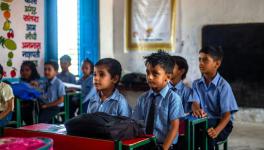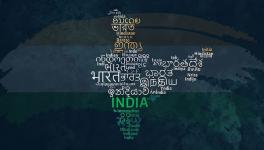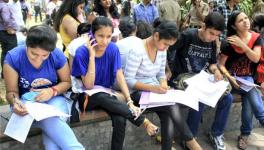Why Isn’t India Doing its Best to Educate Children of the Poor?

Representational Image. Image Courtesy: Flickr
Every society tries to realise its vision of the future through its education system. Providing a decent education to every child is essential if the future is to be democratic. If egalitarianism is the guiding principle, every child must enjoy the right to good education as much as any other right. India’s liberal democracy could have been expected to educate every child born after independence but it seems this was not a priority for the people running the country. Only now, three generations after independence, are most Indian children finding a place in schools, in an educational scenario stamped with gross inequalities of resources and learning outcomes. Its prime victims are children of the poor who, years after schooling, gain minimal literacy and numeracy.
Instead of addressing these inequalities, the dominant neo-liberal ideology naturalises them. The New Education Policy (NEP) does not promise quality education to every child. Its commitment is only to a universal minimum level of education. If the overwhelming majority of children of the poor fail to cross this level, and only children from affluent families get a decent education through private means—so be it.
The neo-liberal acceptance of class inequalities in education is integrated with an instrumental understanding of its purpose. While the children of better-off classes can gain successful careers through education, the poor and marginal children are equipped with skills required for the kinds of jobs they are expected to get. This is a model of complete subsumption of education under the requirements of the socio-economic order. Contrast this against the understanding of education as an autonomous activity that develops the cognitive, social, and psychological abilities of the young. According to this model, education is a transformative activity that builds the subjectivity of a knowledgeable, rational, creative, and empathetic person.
Failing the Poor
The Annual Status of Education Report for 2022 released in January confirms, like all previous reports, that a significant proportion of schoolchildren in rural India fail to acquire basic reading and arithmetic abilities despite years of formal education. Nearly one in three class VIII pupils cannot read a class II text, and more than half in class VIII cannot perform simple division.
A closer look at ASER 2022 shows deeper trends. The proportion of boys and girls aged 15 to 16 years not enrolled in schools has dropped significantly. In 2006, nearly 21% of adolescents in this age band in rural India were not enrolled in a school. By 2018, before the pandemic, their numbers dropped to 12%. In 2022, after the pandemic, this number fell further to 7%. Since children from poor and marginal sections are more likely to be out of school, we can safely infer that the higher enrolment ratio is because more children from these sections are attending schools.
However, the proportion of children in government schools, which provide free education and mid-day meals, textbooks, and uniforms, is declining. In 2006, nearly 73% of rural children were enrolled in government schools, which dropped in 2018 to 66%. In 2022, it increased to 73%, but this post-pandemic increase can be attributed to economic distress, which will likely reverse as the economy stabilises.
Therefore, we have a trend of decreasing enrolment in government schools while overall enrolment rises. It implies that more and more children are studying in fee-charging private schools. In 2006, around 6% of rural adolescents aged between 15 and 16 years studied in private schools. In 2018, their proportion grew to around 22%. So, hidden beneath the rising enrolment is the trend of social differentiation in place and type of education. Children from the better-off rural strata are increasingly studying in private schools, while the public education system is predominantly patronised by the poor and marginalised sections of society.
According to the Socio-Economic and Caste Census, 2011 and the Agriculture Census 2011, 51% of rural Indian households live on casual manual labour. Of the 30% of rural households which do cultivation, nearly two-thirds are marginal farmers. So, the proportion of households dependent on casual labour and marginal agriculture in rural India was nearly 70%, approximately the same percentage as rural children enrolled in government schools—where the education standards are inadequate.
In 2012, 73.4% of government school students in class VIII could read standard II texts, a percentage that dropped to 69% in 2018. The percentage of these students who could divide dropped from 44% to 40% in the same period. And while the infrastructure of government schools has deteriorated, the proportion of mixed-grade classes has increased. In 2010, nearly half the primary schools had mixed-grade classes, rising to nearly two-thirds in 2022. The pupil-teacher ratio over this period increased from one teacher for 39 students to one for 55.
The correlation between socio-economic class and the place and type of education impacts the educational abilities of children. ASER-type surveys measure basic literacy and numeracy, skills essential but not equivalent to education, which would include higher-order cognitive abilities. The data on skills is only a reasonable measure of the deficit in education rather than its content. With this caveat, let us look into the relative levels of learning in government and private schools.
Children in private schools have a clear head start. The proportion of class III rural students in private schools who can read a class II text is nearly double that in government schools. In 2018, it was nearly 41%, compared with 21% in government schools. The same holds for arithmetic abilities. Only 21% of students of class III in rural government schools could subtract in 2018—less than half the 43.5% enrolled in rural private schools. As expected, access to English learning is even more skewed. In 2016, the percentage of class V students in private rural schools who could read an English sentence was three times higher than in government rural schools, 47.3% versus 15.4%.
Inequalities in the educational status of rural poor and urban rich children will be even starker than what the data indicates.
School Education Under Neoliberalism
Progressive critiques of neoliberalism often focus on privatisation and the withdrawal of the State from essential public services like education, health, and housing. It is as necessary to understand the effects of its ideology and methods of operation, which have a broader impact than economic policies.
The market is the only form of sociality neo-liberalism recognises. Like everything in the market, education has a price, and if only the rich can afford quality, so be it. The State would provide free education to the poor as a measure of social welfare—but only a minimal level of it, and for political expediency.
The only institutional administration that neoliberalism understands is the managerial model of capitalist corporations based on centralised control, the dispensability of people who do the work, and quantitative rankings. Its natural outcomes are the visible deterioration in teachers’ working conditions and the gradation of students according to standardised skill tests.
In a neo-liberal state, the chief operating principle of welfare schemes is the mistrust of those who depend on them. Hence, schemes are not run on the principle of inclusion, but the lens of so-called means-testing and targeting, both enforced through surveillance. Governments advertise free mid-day meals, textbooks, and uniforms, but do not hire administrative staff to run these schemes and keep surveillance records. Prime Minister Narendra Modi’s government has gone to the extreme of surveillance. It demands periodic seeding of the Aadhaar information of every child, and their parents, who receive any government support. All the extra non-academic work of running a school and the surveillance of beneficiaries is pushed onto teachers. By some accounts, non-academic work takes up at least 20 or 25 percent of a teacher’s working hours.
School teaching is increasingly a precarious occupation. According to a UNESCO report for 2020, a third of government school teachers—77% of teachers in private schools—had no contract or one with a duration of under a year. It would be even higher for teachers in private coaching and tuition centres. The average monthly salary of teachers in government schools is Rs 26,000. It is Rs 13,000 in private schools. In many States, the average income of a private-school teacher is lower than or just about equal to the official minimum wage.
The quantitative managerial orientation of neoliberalism reduces basic education to literacy and numeracy skills which can be tested and certified when needed. The mobilisation of the system through authoritarian means for programs like the National Literacy Mission, and the publicity around literacy skill tests by outside agencies may increase the scores on standardised tests for these skills. But these miss the essential point of education to develop cognitive abilities.
Palliative Tricks of a Hegemonic System
Neoliberalism would not be half as successful if it focused only on denial of public goods, including education, to the majority. Like all hegemonic ideologies, it incorporates the deprived and the excluded within its fold by strategically creating an aspirational association with the visible life practices of the wealthy. In other words, it convinces the poor they would be better off if only they could have what the rich have. This wards off the potential for antagonism between the rich and the poor by channelling the aspirations of the disadvantaged and the poor into imitating the rich rather than challenging their systemic privileges.
This way of thinking motivated the provision of 25% seats in private schools to children from economically weaker sections (EWS) and disadvantaged groups under the Right to Education law, a patchily implemented policy at best. According to March 2022 news report from Telangana, hardly any of the 1.75 lakh seats for the EWS and disadvantaged students had been filled in the State, and school principals cited the ‘lack of hygiene’ among poorer students as one reason for the neglect. According to a study by the National Commission for the Protection of Child Rights in Delhi, whose State government claims to be pro-actively implementing the policy, only 18% of the mandatory 25% of students were admitted to entry-level classes in private schools. The dropout rate among students admitted under this policy was around 10%. Only 10% of new admissions due to vacancies in higher classes went to the beneficiary category of students.
Even if implemented faithfully, only a fraction of children from these categories can access private school education. Quality education for all other children remains unaddressed. The policy implicitly acknowledges that State-run schools will not provide education of the quality that private schools can provide.
There are the pedagogical and psychological consequences of removing young children from the milieu of their homes and neighbourhoods and placing them (even for a few hours a day) in an unfamiliar and more affluent environment. Their families cannot provide the resources available to their better-off peers. According to the NCPCR report, many parents find it tough to buy textbooks prescribed in private schools and cannot pay for group outings like picnics. Almost all private schools teach in English, which can be traumatic for children without exposure to the language at home. A policy driven by a sense of charity for the poor devalues their life world. A healthy, self-affirming psyche for young children would build on the positives of their familial and community lives rather than aiming for what they lack.
Can a child be proud of what her parents do if her family is economically destitute? Can she enjoy playing with her neighbourhood buddies in cramped spaces? Or must she always look across the class divide for anything worthwhile? A healthy school environment should help her develop her abilities in harmony with her circumstances. Government schools—where her peers study—provide inadequate education. If she gets admission to a private school, she is removed from her milieu. Both conditions in neo-liberal India fail her.
Serving the System, or Breaking the Chains?
Integrating education with the neo-liberal socio-economic order creates a situation similar to the caste system. The latter uses religious injunctions to bar non-Dwijas from education. Neo-liberal India uses market forces and State administration to ensure children get an education commensurate with the class hierarchy. But this is not the only education possible. The first law minister and anti-caste leader BR Ambedkar emphasised the radical role of education in breaking the chains of caste. Its radical potential lies in its ability to fashion humans who can think for themselves, and challenge the belief systems and social institutions which tie them up in unequal relationships and stymie their freedom. Indian schools do not provide this education. However, its lessons cannot be missed, since the school of life itself teaches them to the poor every day.
The author teaches physics at St Stephen’s College, Delhi. The views are personal.
Get the latest reports & analysis with people's perspective on Protests, movements & deep analytical videos, discussions of the current affairs in your Telegram app. Subscribe to NewsClick's Telegram channel & get Real-Time updates on stories, as they get published on our website.
























